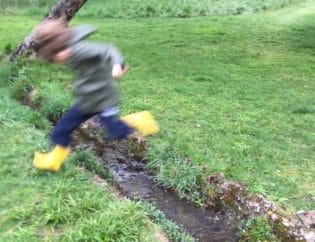
Maybe your child can’t be kept inside, is the first up for a morning hike or planning your next venture into the backcountry together. Fantastic! Your child is a wild child and is benefitting from nature and establishing a lifelong connection to the outdoors.
However, the sad fact is that many kids today can’t think of ways to entertain themselves beyond the screen. How many playdates have you hosted in which the kids turn to you after about 15 screen-free minutes and declare that they’re bored (as if you should sort this out for them)? Many kids are uncomfortable in the outdoors, even fearful of anything outside. These kids are not accessing the perks of nature, to the detriment of their mental and physical health, attention, focus, executive function, resilience, social skills and so much more.
Sadly, these children’s childhood memories will be made indoors, away from nature, and dominated by screen time. And, after all, who remembers their best day of watching tv or youtube?
It’s easy to point fingers at parents who are “allowing” this to happen. But, we’re all trying our best. And with some tips or tricks (as we like to call them) you can transform your reluctant nature kid into a full-fledged wild child.
Here's how to turn the toughest indoor kid into a nature lover.
Trick 1: Keep out
Let's start by thinking back to your own childhood, remembering what you loved most about being outside. Likely space, freedom and time away from adults was a big draw. Childhood is different today than it was in the 70s or 80s. It’s more controlled, structured, and stressful. But kids haven't changed. They still need adult-free time to explore and learn on their own, at their own pace. Here’s where you should resist all temptation to organize, itemize, and otherwise get involved in your child’s time outside. Forget learning, projects or goals. Let your child’s outdoor time be their own time, unstructured and free. If they think of the outdoors as their place, free from adult micromanagement, they will want to keep going back.

Trick 2: Keep it Simple
One afternoon (pre-Covid), I heard strange sounds coming from a back window. I looked outside and saw a small group of children running around their small urban backyard. It wasn’t much more than an extended overgrown city lot. But these kids were having a blast. Two things struck me. One, I had never seen kids playing in that backyard or any other nearby backyard for that matter. Kids in town go to sports games, classes or the playground. The backyards are neglected. Two, this strange sound was nostalgic. It was actually an everyday sound from my own childhood: kids playing outside our window until dinner time. Each afternoon. Every day. With abandon.
It occurred to me that perhaps the reason these kids were having so much fun was that the space was so simple and yet undiscovered for them. Kids love secrecy and hiding out, even (or especially) in ordinary spaces. As children and nature guru Richard Louv puts it, “Expeditions to the mountains or national parks often pale, in a child’s eyes, in comparison with the mysteries of the ravine at the end of the cul de sac.”

Trick 3: Encourage their independence
As kids get older and become tweens and teens, one of the best things you can do for them is to help them, safely, become more independent. The outdoors is a great place for them to start out.
When you give kids a little responsibility as they get older, such as running errands or making trips to the library, they feel accomplished and confident. A great way to start them off heading outside safely is to give them the right tools. Sketch out a neighborhood map together and set boundaries, places of interest such as stores, friends’ houses and of course green spaces. Expand the range of the map as they get older and show more responsibility and good decision-making.
Trick 4: Take a buddy
Some kids will do anything if you let them take a buddy along. Sure, this alters family time and your vision of a bonding experience in nature with your child. But sometimes, it’s the only way you can convince your child to spend the day hiking with you instead of heading off to a playdate. Family nature groups of several families are also a fun way to get outside with your kids and enjoy some socializing (pre or post-Covid of course).

Trick 5: Make it competitive
It’s just in their nature. Some kids are just purely motivated by competition. Use this to your advantage to get them outside without looking at the clock. Set up a tree-climbing contest in a local park or set off on a nature scavenger hunt where your kids collect items from nature. You can also head out geocaching together.
Trick 6: Try secondhand nature
Experiencing nature indirectly such as through screens, books, videos, etc. is what some call “second-hand nature.” Many experts tell us that even indirect exposure is important and can significantly influence children’s connectedness to nature. For example, studies find that children’s literature that focuses on the beauty and wonder of nature can help young children develop an understanding and appreciation of the natural world. Or that viewing nature-focused films may prompt children to associate “self” with “natural” vs. “built” environments. So if yours is truly an indoor child, you can still get nature to your child, it just might be in the form of books, documentaries or apps. So don’t feel guilty about putting on a nature documentary on a rainy day or reading books about nature together.

Trick 7: Build in into your vacation
Whether you’re staying close to home or seeking big nature experiences on the road, make nature the main feature of your family vacation this year. Think of locations that offer many options to get out and explore through hiking, biking, kayaking or climbing. Our favorite source for planning adventure vacations is without a doubt The Big Outside. This well-written blog is by writer, traveler, and dad Mike Lanza. Mike has taken his kids on the ultimate adventures in the outdoors. But don't be intimidated! Mike offers tips for trips of all sizes and level and has generously created this blog as a resource for other adventure-seeking parents.
Pro Tip: Don’t forget to download your fourth grader's Every Kid Outdoors pass, which gives your entire family FREE access to hundreds of parks, lands, and waters for a year!
Trick 8: Make it all-inclusive
Sometimes all it takes is being asked for their opinion. Before you draft up a nature-filled schedule, try out some ways that involve the entire family in nature planning. Spend Friday night playing nature adventure bingo. Create your own bingo cards or print the game cards we made up for the whole family arranged with possible nature activities and call them out. The winning card/combination is the activity for the next day!
Or try out the Family Nature Bucket List idea from Nurture by Nature, which is a fun way to select your family’s ideas for nature-based activities using color-coded clothes pins.
Trick 9: Get creative
If yours is the creative type, encourage your child to build or create something out of nature such as nature art, fairy houses, journey sticks, mandalas or stick forts. Or help your child set a goal to take on a nature-based project like a wildlife film or a nature photography exhibit. Observing and photographing or filming nature is an enriching hobby that helps your child observe and learn in nature. To be a good nature photographer, filmmaker, or artist, your child will have to learn how to be a "quiet observer," practicing patience and bodily control as they look for signs of how wildlife uses habitat for food, water, cover, a place to raise young. These are all excellent ways for any child to experience tuning into the natural world and connecting with nature.

https://www.flickr.com/photos/stevendepolo/8297957561
Trick 10: Model
The biggest reason kids don’t spend more time in nature is that their parents don’t. If your children see you’re not interested in and don’t value the outdoors, neither will they. Conversely, if you lead by example, showing them a genuine love of nature yourself, they’ll typically adopt the same attitude. So go ahead and take on some new outdoor hobbies for yourself.











